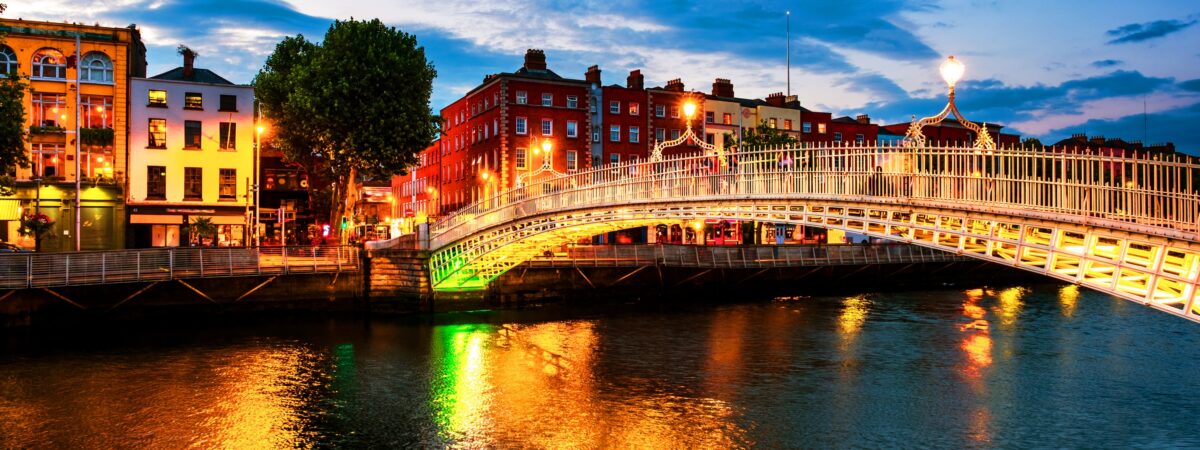
 Tourist attractions
Tourist attractions  Restaurants, irish pubs
Restaurants, irish pubs  Accomodations
Accomodations  Campings
CampingsDublin is currently experiencing a real housing crisis. Accommodation prices can explode depending on your area (the closer you are to the city center, the higher the rate).
Our advice: choose the suburbs or coastal villages as your base… and take the DART to explore Dublin! Your wallet will thank you!
Dublin is the official capital of the Republic of Ireland. A cosmopolitan, young and lively city, Dublin has been enjoying unprecedented growth for several years now, and is now one of the trendiest capitals in the world!
The city has a lot to offer globetrotters: first and foremost, Dublin is the cradle of Irish literature. This is the home of such literary talents as Oscar Wilde, Samuel Beckett and James Joyce. But also because the city is teeming with tourist attractions and things to do! Museums, visits to local breweries and distilleries… not to mention places steeped in history that are a must-see… You won’t be bored!
Whether it’s for a weekend in Dublin, or for a more in-depth discovery of the city, the place never ceases to surprise tourists from all over the world with the quality of its activities, the atmosphere of its Georgian streets, its pubs, its museums…etc! Here’s a presentation of this colorful capital, which has nonetheless retained its human scale…

We’ll keep it short, but it’s always good to know: the very first origins of Dublin can be traced back to 140 A.D. by Ptolemy, when the city was named Eblana.
It was probably a tiny fishing and farming village built not far from the River Liffey.
It wasn’t until the 9th century that a town was built on this very spot, and christened“Dubh Linn” (Black Pond) by the Vikings. They built an imposing fort on the site of today’s Dublin Castle.
By 1213, Dublin had fallen into the hands of the Anglo-Normans, who took advantage of the opportunity to build a new castle on the orders of King John: Dublin Castle, still intact today and a symbol of Anglo-Norman domination over the Irish.
Over the centuries, the town developed and became an important commercial crossroads. However, the city was torn apart by numerous conflicts between the Irish and the English. The latter want to impose their domination on the island, which is not to the liking of the Irish… and especially not the Dubliners.
A terrible conflict that continued into the 20th century, when a revolt was organized in 1916, known as the Bloody Easter (Easter Uprising). The Irish took up arms and intended to retake Dublin, then in English hands. Although the uprising was ultimately a failure, and the city suffered extensive damage (buildings destroyed, many deaths, etc.), Dublin carries the date as a major event in Irish history. It was the detonator that triggered the Irish War of Independence, then the Civil War… and finally the Independence of the Republic of Ireland (with the exception of Northern Ireland, which remained under British rule).
Since then, Dublin has been a pretty cool, quiet city. In perpetual motion, the area is now known as the headquarters of numerous high-tech companies (Facebook and Google to name but a few), and shines with its economic influence. Students from all over the world come to attend courses at the prestigious Trinity College University, restaurants offer constantly innovative cuisine… and tourist activities provide a unique experience for travelers!

Did you know? Today, Dublin is one of the most visited corners of Ireland! Many Europeans take a flight or ferry to spend a few days in the Irish capital.
The Irish capital is easy to reach by plane. Allow around 1h30 from Paris.
It is generally appreciated for its museums (many of which are free), its castles, its river Liffey which crosses the city, whiskey distilleriesIrish beer breweries (including the famous Guinness Storehouse), its Temple Bar with its ultra-fashionable Irish pubs, its restaurants, the new jewels of Irish cuisine, its colorful doors, its Georgian-style buildings… not to mention its many festivals held throughout the year!
Let’s not forget that Dublin is THE capital where you can celebrate St. Patrick’s Day, Ireland’s national holiday, celebrated every March 17! Don’t miss the Grand Parade, the concerts and the unusual activities: the atmosphere is festive and a great way to meet the people of Dublin!
Don’t be surprised when you visit the city: Dublin is a skilful blend of tradition and modernity. A somewhat disjointed patchwork of ultra-modern buildings (particularly in the Docklands district), but also of historic areas, with their Georgian quarters, colorful gates, historic distilleries and breweries, huge parks… and wastelands or derelict buildings… and so on. It all fits together perfectly, giving it a unique charm!
Active and dynamic, Ireland’s capital has above all retained its human scale. Distances are easy to cover thanks to its bus network, tramway (the Luas) and DART (the equivalent of the Paris RER).
People here cultivate a very pleasant art de vivre, where the human being remains at the center of everything. Very quickly, you find yourself seeing Dublin as a kind of large village, where modernity has no hold on human warmth.
Generally speaking, Dubliners are cool and hip, but still warm and approachable. They take the time to help travelers with questions or problems.
So discover Dublin at your own pace! Push open the doors of their museums and establishments. You’ll find an authentic, picturesque town that’s a pleasure to discover!